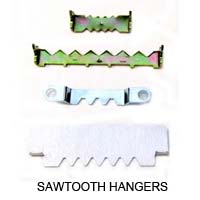| Glossary Of Giclee Terms
[5] |
N
Nail-less hangers Any hanger or hook that does not require a nail to affix it to the frame or wall.
(1) sawtooth hangers generally have a pointed tip on each end that can be pressed or hammered into the top back of the frame. A nail or other hook is required to hang it on the wall, however.
(2) Adhesive hangers are popular today, and are comprised of a flat, double-sided adhesive that affixes the hanger to the wall. When the hanger needs to be removed, a tab attached to the adhesive is pulled, and the entire piece comes off without ruining the wall.
(3) A hanger with sharp teeth that can be pressed or hammered into the wall. The face is then flush with the wall, providing a jutting hook on which to hang the artwork. |
 |
| Negative A negative is an image, usually on a strip or sheet of transparent plastic film, in which the lightest areas of the photographed subject appear darkest and the darkest areas appear lightest. This reversed order occurs because the extremely light-sensitive chemicals a camera film must use to capture an image quickly enough for ordinary picture-taking are darkened, rather than bleached, by exposure to light and subsequent photographic processing. |
Noise Reduction Noise reduction is the process of minimizing or eliminating unwanted noise from digital images to improve overall image quality and clarity. In digital photography, noise reduction techniques are used to reduce the visibility of noise artifacts, such as grain or speckles, caused by factors such as high ISO sensitivity, low-light conditions, or limitations in the camera's image sensor. Noise reduction algorithms analyze the pixel data in an image and apply smoothing or averaging techniques to suppress noise while preserving image detail and sharpness.
Many digital cameras feature built-in noise reduction settings that automatically apply noise reduction processing to images during capture, while advanced image editing software also offers noise reduction tools that allow photographers to fine-tune noise reduction parameters during post-processing. When applying noise reduction, it's important to strike a balance between noise reduction and image sharpness, as excessive noise reduction can result in loss of detail and a "plastic" appearance in the final image. Photographers should experiment with different noise reduction settings and techniques to achieve the desired balance between noise reduction and image quality in their photographs. |
| Non-Glare Glass Glass where one or both surfaces have been treated chemically or mechanically to slightly roughen the surface, causing reflected incident light to be dispersed in all directions. Because the glass surface is not smooth, art images behind the glass tend to be softened. The softness depends on how far the art is from the glass. No more than two or three mats are recommended to be used with non-glare glass. If clarity is desired, objects in deep frames (shadow boxes) should not be displayed with non-glare glass. |
Numbered Ducks A type of cotton canvas that subscribes to a numbering system that identifies the weight of the cloth. Numbered duck has a weight of less than 19 ounces per 36x22" piece. Duck canvas with a higher weight is called naught duck.
Order online: #10 and #12 Canvas |
|
© 2002-2025 - KeenART Media Ltd.
|
|
| |
|

